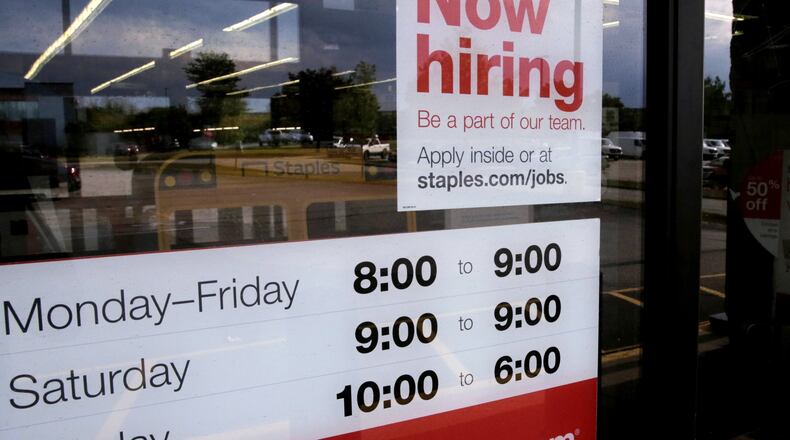Editor’s note: This article has been updated throughout with additional details.
The Georgia economy capped its tenth consecutive year of growth with new job gains in December as the unemployment rate reached a new low.
But the pace of hiring decelerated from 2018. The 3,900 jobs added last month were about one-third as many as Georgia averaged for the five previous Decembers. The year's growth – 66,700 jobs – was the weakest since 2011.
That was still good enough to snip the state's unemployment rate to 3.2% from 3.3% in November. It represents a new record low since the government started keeping track in the mid-1970s, the Georgia Labor Department reported Thursday.
"Georgia closed out 2019 on a very high note," said Mark Butler, the state's labor commissioner.
The labor market has steadily improved from the depths of the Great Recession, when the unemployment rate was in double-digits and nearly a half-million Georgians were unemployed.
A decade later, the American consumer has continued to spend and domestic-dependent companies have generally done well in what is the longest U.S. economic expansion on record.
Overall job growth, though, has been slowing for some time. The biggest years for Georgia were 2014, when the state added 137,900 jobs, and 2015, when it added 112,900 jobs.
Among worrying signs in last month’s numbers were dips in hiring among sectors tied to international commerce – evidence that U.S. trade wars are damaging some business.
There was also a rise in the number of layoffs, as signaled by new claims for unemployment insurance. About 35,000 people filed claims during the month, up 29% from December of 2018.
Georgia's manufacturing sector lost 900 jobs last month while the sector including warehouses and transportation lost 1,200 jobs – woes that have an international cause, according to Mark Vitner, senior economist at Wells Fargo.
“Slower global economic growth is clearly exerting some drag on Georgia’s economy,” he wrote in an email.
In contrast, the sector that includes restaurants was up 600 jobs for the month and a robust 17,000 for the year. Health care added 2,500 jobs during the month and 22,100 for the year.
As the housing bubble burst in 2007, Georgia's jobless rate rose above the national average and did not fall below it again until a few months ago. The national rate was 3.5% last month, when the U.S. economy added 145,000 jobs in December.
There are still 162,533 Georgians officially unemployed, defined as out of work and actively seeking a job.
The challenge is not spread evenly since unemployment rates differ by race, gender and age, according to the Bureau of Labor Statistics.
Older workers, for example, have a harder time finding another job if they are laid off, said Jen Schramm, senior policy advisor at AARP's Public Policy Institute. "One thing that often comes up with regular people, especially people over 50 struggling to find work, is how the unemployment rate doesn't mesh with their experience."
More than one-quarter of unemployed workers over 55 have been looking for work for at least 27 weeks, compared with 19% for workers between the ages of 16 and 54, according to the BLS.
December’s job growth, Georgia
2014: 17,200
2015: 18,300
2016: 11,900
2017: 7,200
2018: 10,700
2019: 3,900
Sources: Georgia Department of Labor, Bureau of Labor Statistics
Unemployment rate, Georgia
High: 10.6% (Dec. 2010)
Low: 3.2% (Dec. 2019)
Current: 3.2%
Sources: Georgia Department of Labor, Bureau of Labor Statistics
Growth in Georgia labor force
2014: 16,532
2015: 72,536
2016: 171,555
2017: 100,058
2018: 19,679
2019: 17,543
Sources: Georgia Department of Labor, Bureau of Labor Statistics
Georgia’s best years for job growth
2014: 137,900
2015: 112,900
2005: 108,200
2016: 102,000
2018: 92,500
2013: 88,800
2004: 78,800
2006: 73,100
2012: 70,300
2017: 69,400
2019: 66,700
2000 55,600
Sources: Georgia Department of Labor, Bureau of Labor Statistics
Seasonal hiring: Jobs added, Oct.-Dec.
2014: 35,300
2015: 39,000
2016: 21,800
2017: 33,500
2018: 28,800
2019: 17,700
Sources: Georgia Department of Labor, Bureau of Labor Statistics
About the Author
Keep Reading
The Latest
Featured

